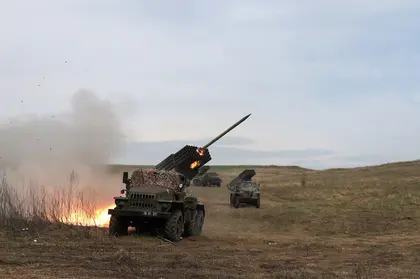Russian Federation (RF) attacks in the eastern Donbas sector have ground to an effective halt, as new evidence mounted of Ukraine Armed Forces (UAF) attacks gaining ground in the neighboring Kharkiv sector, and possibly threatening a key RF supply line, news and official sources said on Wednesday.
A May 4 statement from Ukraine’s Army General Staff (AGS) said that RF forces were pushing hardest along the Siviersky Donets River line near the town Lyman, but that UAF defenses had repelled the attacks and inflicted serious losses. Battles still were in progress for control of crossings over the river at other locations, but thus far UAF forces on the south/right bank of the Siviersky Donets were holding, the statement said.
JOIN US ON TELEGRAM
Follow our coverage of the war on the @Kyivpost_official.
The Siviersky Donets River in recent weeks has become a major barrier to RF attempts to drive south and capture the cities of Sloviansk and Kramatorsk. Moscow’s main objectives for its Donbas offensive are controlling key cities and towns in the region, and ejecting UAF forces from the Donbas’ Luhansk and Donetsk regions.
Ukrainian forces appeared to be continuing a limited offensive to the northwest of the Siviersky Donets River line, near the town Izium. Initial indications of possible UAF spoiling attacks in the vicinity first became public on Friday. On May 5, both official Ukrainian sources and RF-controlled media seemed to agree advancing UAF units had captured the towns of Oskil the villages of Stary Saltiv and Moldova, potentially threatening RF supply lines running through Izium.
The Kremlin-controlled Readaktova on May 4 claimed UAF forces in Oskil, at the south end of the Oskil reservoir, numbered nearly 1,000 men were “completely surrounded” by RF forces, and that the UAF drive “posed no threat” to Moscow’s Donbas offensive. UAF forces in Oskil, Stary Saltiv, and Moldova would, potentially, directly threaten RF supply shipments moving from railheads near the Russian border to RF troops fighting along the Siviersky Donets.
Social media videos posted on Wednesday and Thursday by UAF units thought to be in the vicinity, including by 92nd Mechanized Brigade and 81st Air Assault Brigade, showed images of UAF artillery shattering RF armored vehicles and supply trucks, allegedly in strikes in the Izium sector. Other posts, sometimes documented by UAF troopers standing in the village, declared Oskil and Stary Saltiv fully under UAF control.
In a concession of UAF success rare for Kremlin-controlled media, and in a sharp overnight reverse of its past claims, Readaktovka editorialized on May 5: “Unfortunately directly on the ground, the situation is not changing as quickly as one might like. Things are unsettled in Kharkiv (sector). The enemy (the UAF) has brought big forces here…(and is) attempting to attack our flank, and at some locations, he is succeeding, which, of course, creates a danger to out rear areas and supply.”
Elsewhere along the Donbas’ 500+ kilometer line of contact, Ukrainian officials reported renewed RF artillery bombardments and aerial bomb attacks on homes and businesses near the fighting, but very few RF attempts to advance on the ground. Hardest-hit, said Luhansk regional defense command head Serhiy Haidai in a statement, were the battlefront towns Servordonetsk, Rubizhne, Lysychansk, and Zolota-4. Two civilian men died in Popasna and two civilian women were injured in Lysychansk, and 45 homes were damaged, as a result of a total RF 34 attacks, he said. Street fighting was in progress in Popasna, Haidai said.
The news of halted RF progress and possible UAF advances in the Kharkiv-Izium sector came against a background of a new wave of missile strikes, some reportedly Oniks anti-ship weapons launched by RF bombers flying over the Caspian Sea, at targets across Ukraine overnight. According to Ukrainian official counts, eighteen weapons struck hitting mostly homes and businesses.
Military analyst Oleh Zhdanov in comments to the UNIAN news agency said that the RF likely was turning to the use of expensive anti-ship missiles against Ukrainian ground targets, because Moscow’s land offensive in Donbas has stalled decisively, and that the Kremlin’s forces have almost run out of long-range land missiles. Without turning to fire anti-ship missiles at Ukrainian ground targets, the Kremlin would be seen as unable to achieve its objectives in Ukraine by any means at all, and at a loss, Zhdanov said.
You can also highlight the text and press Ctrl + Enter



